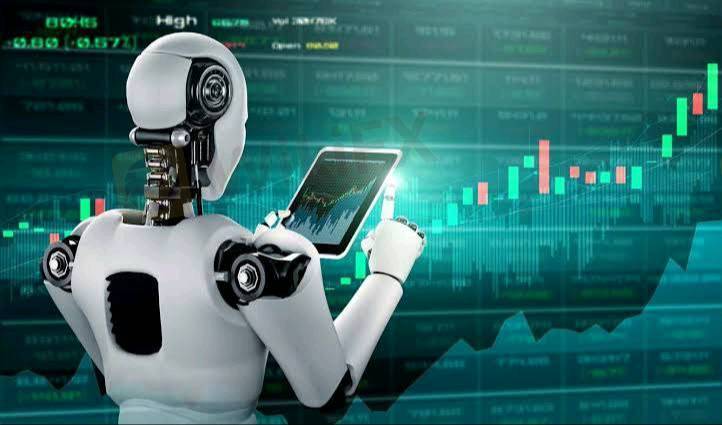
2025-03-31 12:39
业内Al's Role in Forex MarketHigh-Frequency Market Mak
#AITradingAffectsForex
AI is playing an increasingly crucial role in high-frequency market making within the forex market. This area of trading, characterized by extremely rapid transactions, relies heavily on advanced technology, and AI is proving to be a powerful tool. Here's how AI is influencing high-frequency market making:
Understanding High-Frequency Market Making
* High-frequency market making involves providing liquidity to the forex market by continuously placing buy and sell orders.
* These market makers aim to profit from the bid-ask spread, the small difference between buying and selling prices.
* Speed is paramount, as opportunities can disappear in milliseconds.
AI's Contributions:
* Ultra-Fast Data Analysis:
* AI algorithms can analyze massive amounts of market data in real-time, far exceeding the capabilities of human traders.
* This includes analyzing order book data, price fluctuations, and news feeds.
* Optimal Order Placement:
* AI can optimize order placement strategies, determining the best prices and quantities to offer based on real-time market conditions.
* This helps market makers to maximize their profits while minimizing their risk.
* Risk Management:
* AI can assess and manage the risks associated with high-frequency trading, such as:
* Adverse price movements.
* Sudden changes in market liquidity.
* AI-driven systems can dynamically adjust trading strategies to mitigate these risks.
* Pattern Recognition:
* Machine learning algorithms can identify subtle patterns in market data that humans may miss.
* This includes detecting:
* Short-term price trends.
* Liquidity imbalances.
* Potential arbitrage opportunities.
* Adaptability:
* AI systems are able to adapt to the constant changes of the forex markets. This is a vital part of remaining profitable in the HFT arena.
Key AI Techniques:
* Machine Learning:
* Algorithms like neural networks and reinforcement learning are used to optimize trading strategies.
* Deep Learning:
* Deep learning models can analyze complex datasets and identify subtle patterns.
Impact:
* Increased Market Liquidity: High-frequency market makers, enhanced by AI, contribute to increased market liquidity.
* Reduced Bid-Ask Spreads: AI-driven market making can lead to tighter bid-ask spreads, reducing transaction costs for traders.
* Increased Market Efficiency: AI contributes to greater market efficiency by enabling faster and more accurate price discovery.
It's important to note that high-frequency trading and the use of AI within it, is a complex and sometimes controversial subject. There are on going discussions about the risks that are associated with HFT.
赞 0
harden9446
交易者
热门讨论
业内
哎,现在明白不赌就是赢啊
行情分析
美元/加元技术面
技术指标
外汇技术分析之波浪理论
业内
[活動]論交易,贏取200元話費補貼
技术指标
EZ.Fury Kite是基于趋势指标MA进行判断
技术指标
指标派是什么?
集市分类

平台

展会

IB

招聘

EA

业内

行情

指标
Al's Role in Forex MarketHigh-Frequency Market Mak
 美国 | 2025-03-31 12:39
美国 | 2025-03-31 12:39#AITradingAffectsForex
AI is playing an increasingly crucial role in high-frequency market making within the forex market. This area of trading, characterized by extremely rapid transactions, relies heavily on advanced technology, and AI is proving to be a powerful tool. Here's how AI is influencing high-frequency market making:
Understanding High-Frequency Market Making
* High-frequency market making involves providing liquidity to the forex market by continuously placing buy and sell orders.
* These market makers aim to profit from the bid-ask spread, the small difference between buying and selling prices.
* Speed is paramount, as opportunities can disappear in milliseconds.
AI's Contributions:
* Ultra-Fast Data Analysis:
* AI algorithms can analyze massive amounts of market data in real-time, far exceeding the capabilities of human traders.
* This includes analyzing order book data, price fluctuations, and news feeds.
* Optimal Order Placement:
* AI can optimize order placement strategies, determining the best prices and quantities to offer based on real-time market conditions.
* This helps market makers to maximize their profits while minimizing their risk.
* Risk Management:
* AI can assess and manage the risks associated with high-frequency trading, such as:
* Adverse price movements.
* Sudden changes in market liquidity.
* AI-driven systems can dynamically adjust trading strategies to mitigate these risks.
* Pattern Recognition:
* Machine learning algorithms can identify subtle patterns in market data that humans may miss.
* This includes detecting:
* Short-term price trends.
* Liquidity imbalances.
* Potential arbitrage opportunities.
* Adaptability:
* AI systems are able to adapt to the constant changes of the forex markets. This is a vital part of remaining profitable in the HFT arena.
Key AI Techniques:
* Machine Learning:
* Algorithms like neural networks and reinforcement learning are used to optimize trading strategies.
* Deep Learning:
* Deep learning models can analyze complex datasets and identify subtle patterns.
Impact:
* Increased Market Liquidity: High-frequency market makers, enhanced by AI, contribute to increased market liquidity.
* Reduced Bid-Ask Spreads: AI-driven market making can lead to tighter bid-ask spreads, reducing transaction costs for traders.
* Increased Market Efficiency: AI contributes to greater market efficiency by enabling faster and more accurate price discovery.
It's important to note that high-frequency trading and the use of AI within it, is a complex and sometimes controversial subject. There are on going discussions about the risks that are associated with HFT.
赞 0
我也要评论
提问
0条评论

还没人评论,赶紧抢占沙发

提问
还没人评论,赶紧抢占沙发